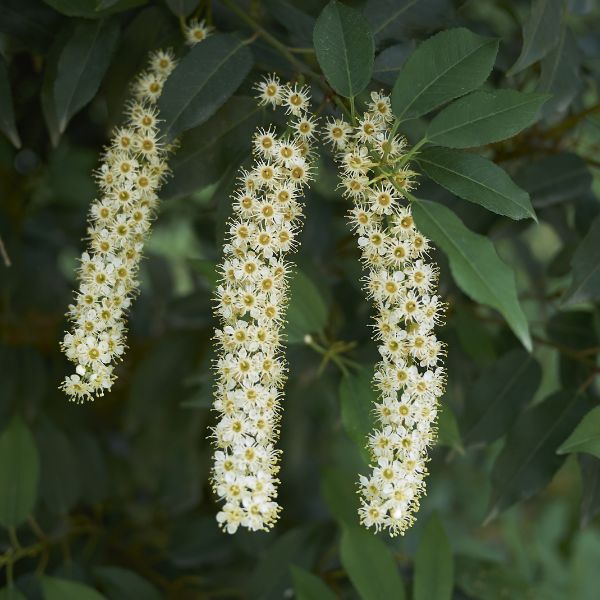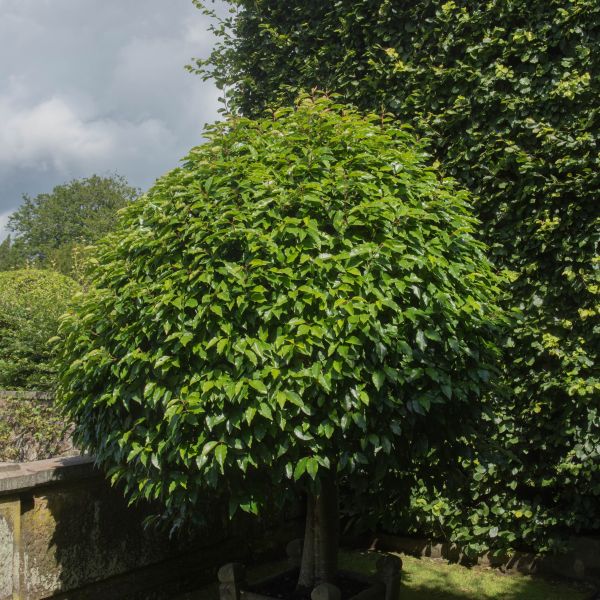


Portuguese Laurel
Prunus lusitanica
90 reviews
Portuguese Laurel
Prunus lusitanica
90 reviews
- Dense and bushy evergreen foliage provides year-round privacy
- Tolerant of a variety of soil types and conditions
- Low maintenance and easy to prune into desired shape
- Recommended by landscape designers for optimal fit in real yards
$54.00
$78.00
30% Off
- Ships to in 7-10 Days
- Free Shipping Over $150
- Plant Arrival Guarantee
- In Stock
- Free Plant Consult
$200 - Landscape-Approved: Every Plant We Sell Comes With Design Expertise Behind It
- 1 Gallon
- 3.5 Gallon
We are sorry, product is currently out of stock due to seasonal availability. Please check the "Related plants available in your area" section below
Not just beautiful - intentionally selected by ShrubHub's 3D landscape design team to fit real-world spaces and maximize yard potential.
Why Portuguese Laurel?
Portuguese Laurel (Prunus lusitanica) is a popular evergreen shrub/tree native to Portugal and Spain. It is commonly used as a hedge or screening plant due to its dense growth and ability to tolerate pruning. The foliage is dark green and glossy, and it produces small fragrant white flowers in early summer, followed by red-black berries in the fall. It is a hardy plant that can grow in full sun to partial shade and prefers well-drained soil.
Sunlight
Portuguese Laurel thrives in full sun to partial shade, ideally receiving at least 4 to 6 hours of direct sunlight per day. It can tolerate some shade, but its growth may be slower and it may have a denser habit in full shade.
Watering
Portuguese Laurel requires regular watering, especially during hot and dry periods. It prefers moist, well-drained soil and should be watered deeply and infrequently rather than frequent shallow waterings.
Fertilizing
The fertilizer requirement for Portuguese Laurel is generally low, as it is a hardy plant that can tolerate a range of soil conditions. However, a slow-release balanced fertilizer applied in spring and early summer can help promote healthy growth.
Portuguese Laurel: A Fragrant Beauty for Your Garden!
Get ready to be captivated by the Portuguese Laurel, a stunning addition to your landscape.
This remarkable shrub showcases fragrant 10-inch white blooms, filling the air with a delightful aroma. Enjoy the beauty and elegance of this laurel as it graces your garden with its enchanting flowers.
The Portuguese Laurel boasts lush dense dark green foliage, creating a lush and vibrant backdrop to its fragrant blooms.
Enjoy the year-round beauty of this broadleaf evergreen, adding a touch of elegance to your garden even during the colder months.
With its large-sized shrub or tree form, the Portuguese Laurel is a versatile choice for your garden.
It can be trained into formal or informal hedges, serving as backdrops, windbreaks, and privacy screens. Embrace its adaptability and find the perfect way to incorporate it into your outdoor space.
This laurel thrives in both full sun and partial shade, providing flexibility in your garden design.
It appreciates well-drained soil, even tolerating clay soil. With moderate moisture, it can tolerate dry shade once established, making it a low-maintenance and resilient plant.
To enhance the health and growth of the Portuguese Laurel, it appreciates mulch around its base.
Mulching helps retain moisture, regulates soil temperature, and prevents weeds, contributing to the overall well-being of the plant.
Pruning the Portuguese Laurel after flowering helps maintain its shape and promotes healthy growth
As a bonus, the Portuguese Laurel is deer resistant, ensuring that it remains undisturbed in your garden.
Indulge in the beauty and charm of the Portuguese Laurel.
Visit our ShrubHub store today and bring home this fragrant beauty.
Order now and elevate your garden with the Portuguese Laurel!
Plant Information:
| Botanical Name: | Prunus lusitanica |
| USDA Zones: | 6 - 9 |
| Water: | Moderate |
| Exposure: | Full Sun |
| Soil Needs: | Well Drained |
| Mature Height: | 20 - 25 feet |
| Mature Spread: | 15 - 25 feet |





Pollination Info
Pollination Information for Portuguese Laurel (Prunus lusitanica)
Portuguese Laurel is a self-fertile plant, which means that it can produce fruit without needing pollen from another plant. However, cross-pollination can increase fruit yield and quality.
The flowers of Portuguese Laurel are hermaphroditic, which means that they have both male and female reproductive organs. The flowers are pollinated by bees and other insects that are attracted to the bright white flowers in the spring.
The pollen of Portuguese Laurel is heavy and sticky, which makes it less likely to be carried by wind. Instead, it relies on insects to transfer the pollen from the male reproductive organ (the stamen) to the female reproductive organ (the stigma).
It is recommended to plant at least two Portuguese Laurel plants in close proximity to encourage cross-pollination and increase fruit yield.
FAQ
Portuguese Laurel (Prunus lusitanica) FAQ
1. What is Portuguese Laurel?
Portuguese Laurel (Prunus lusitanica) is an evergreen shrub or small tree native to southwestern Europe and northwest Africa. It is known for its dark green glossy leaves and clusters of fragrant white or pink flowers that bloom in early summer.
2. How tall does Portuguese Laurel grow?
Portuguese Laurel can grow up to 20 feet tall, but it can also be pruned to maintain a smaller size and shape.
3. What soil and sunlight requirements does Portuguese Laurel have?
Portuguese Laurel prefers well-drained soil and full to partial sunlight. It can tolerate some shade, but too much can inhibit flower production.
4. How do you plant Portuguese Laurel?
Portuguese Laurel can be planted from seeds or cuttings in the spring or fall. Dig a hole twice the size of the root ball and place the plant in the hole, making sure the top of the root ball is level with the soil surface. Water the plant well and mulch around the base to retain moisture.
5. How do you prune Portuguese Laurel?
Portuguese Laurel can be pruned in late winter or early spring before new growth emerges. Remove any dead or diseased branches and shape the plant as desired. It can also be pruned to maintain a smaller size.
6. Does Portuguese Laurel require any special care?
Portuguese Laurel is a low-maintenance plant, but it benefits from regular watering during dry spells and fertilization in the spring with a balanced fertilizer.
7. What pests and diseases affect Portuguese Laurel?
Portuguese Laurel is generally not susceptible to many pests or diseases, but it can be affected by aphids, scale insects, and powdery mildew. Proper watering and pruning can prevent these problems.
8. Can Portuguese Laurel be used for hedging?
Yes, Portuguese Laurel is commonly used as a hedging plant due to its dense growth habit and ability to tolerate pruning.
9. What is the best climate for Portuguese Laurel?
Portuguese Laurel grows best in USDA zones 7-9, which have mild winters and moderate summers.
Planting & Care
Planting:
- Choose a well-draining location with partial to full sun.
- Dig a hole twice the size of the root ball and as deep as the container holding the plant.
- Loosen the roots before placing the plant in the hole and backfill with the soil mixture.
- Water thoroughly and add mulch around the base, keeping it a few inches away from the trunk.
Care:
- Water regularly in the first few months of planting to prevent the soil from completely drying out.
- Once established, Portuguese Laurel is drought tolerant but benefits from occasional watering during dry spells.
- Prune in late winter or early spring, before new growth begins, to maintain a desired size and shape.
- Apply fertilizer in early spring and midsummer to promote healthy growth.
- Watch for signs of pests such as borers, aphids, and scale insects and treat accordingly.
- Regularly remove dead or damaged branches to keep the plant looking healthy and vibrant.
Check Out These Verified Customer Reviews:
Customer Reviews
4.6 out of 5 based on 90 reviews
Thank you! Your review has been submitted.
I ordered the Portuguese Laurel and was impressed by the quality of the plant. It looked even better in person than on the website. The customer service was helpful in answering my questions. Overall, a great experience!
Website was easy to navigate
The Portuguese Laurel is a beautiful addition to my backyard. Only minor issue was a small scratch on one of the leaves.
Item has been added to your cart.


